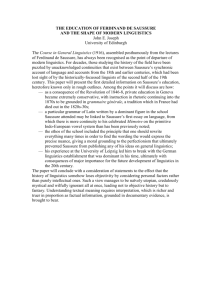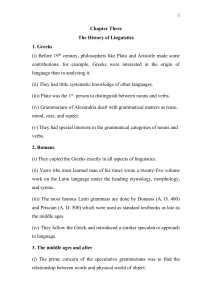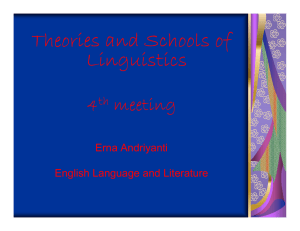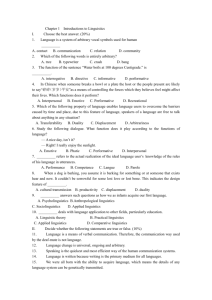Content of speech
advertisement
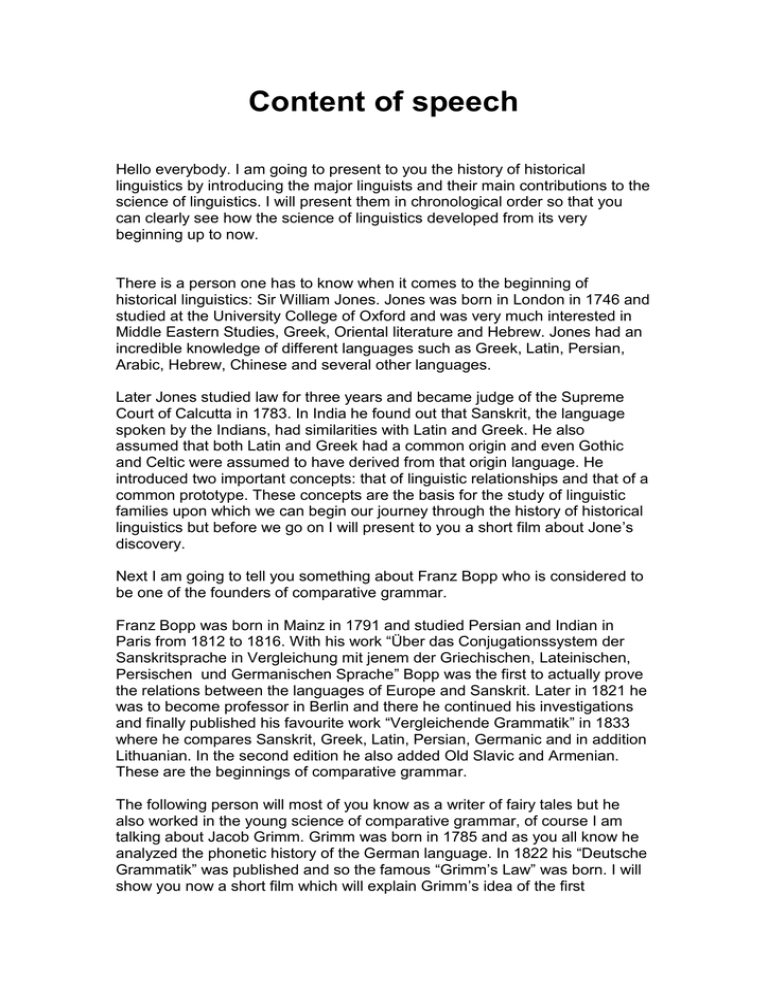
Content of speech Hello everybody. I am going to present to you the history of historical linguistics by introducing the major linguists and their main contributions to the science of linguistics. I will present them in chronological order so that you can clearly see how the science of linguistics developed from its very beginning up to now. There is a person one has to know when it comes to the beginning of historical linguistics: Sir William Jones. Jones was born in London in 1746 and studied at the University College of Oxford and was very much interested in Middle Eastern Studies, Greek, Oriental literature and Hebrew. Jones had an incredible knowledge of different languages such as Greek, Latin, Persian, Arabic, Hebrew, Chinese and several other languages. Later Jones studied law for three years and became judge of the Supreme Court of Calcutta in 1783. In India he found out that Sanskrit, the language spoken by the Indians, had similarities with Latin and Greek. He also assumed that both Latin and Greek had a common origin and even Gothic and Celtic were assumed to have derived from that origin language. He introduced two important concepts: that of linguistic relationships and that of a common prototype. These concepts are the basis for the study of linguistic families upon which we can begin our journey through the history of historical linguistics but before we go on I will present to you a short film about Jone’s discovery. Next I am going to tell you something about Franz Bopp who is considered to be one of the founders of comparative grammar. Franz Bopp was born in Mainz in 1791 and studied Persian and Indian in Paris from 1812 to 1816. With his work “Über das Conjugationssystem der Sanskritsprache in Vergleichung mit jenem der Griechischen, Lateinischen, Persischen und Germanischen Sprache” Bopp was the first to actually prove the relations between the languages of Europe and Sanskrit. Later in 1821 he was to become professor in Berlin and there he continued his investigations and finally published his favourite work “Vergleichende Grammatik” in 1833 where he compares Sanskrit, Greek, Latin, Persian, Germanic and in addition Lithuanian. In the second edition he also added Old Slavic and Armenian. These are the beginnings of comparative grammar. The following person will most of you know as a writer of fairy tales but he also worked in the young science of comparative grammar, of course I am talking about Jacob Grimm. Grimm was born in 1785 and as you all know he analyzed the phonetic history of the German language. In 1822 his “Deutsche Grammatik” was published and so the famous “Grimm’s Law” was born. I will show you now a short film which will explain Grimm’s idea of the first Germanic sound shift, this is important as you will get to know “Verner’s Law” as well . The next linguist I will present to you had an profound influence on the development of linguistics. August Schleicher is part of the second generation of comparatists but it is to mention that Schleicher originally was trained as a botanist. The fact that Schleicher used to be a botanist had a great impact on the way how Schleicher considered languages. He considered languages as natural organisms which are born, then grow and finally die. Consequently Schleicher argued that humans have no influence on language development. From that time on linguistics was considered to be a part of the natural scienes and Schleicher tried to describe linguistic laws with the laws of physics and chemistry. With the help of Darwin’s theories he also tried to explain the evolution of language. Nevertheless Schleicher is famous for introducing his “Stammbaumtheorie” where he visualizes with the help of his genealogical tree in what way IndoEuropean languages are related. This theory was widely accepted and as you all know it still is to this day. Moreover Schleicher adopted the theory of tripartition which was originally introduced by the Indianist Wilhelm Schlegel. In this theory it was assumed that the languages of the world are divided into three classes such as isolating, agglutinative and inflecting. You should know the differences between these terms as we talked about them in the Introduction to Medieval English studies. The interesting point is that Schleicher extended this theory and assumed that every language developed from the isolating state via the agglutinative to the inflecting but as you all know this theory was never accepted due to the fact that for example English developed from synthetic to analytic (isolating). Following I will tell you something about a group of linguists which totally abandoned the principles of comparative linguistics. From the 1870’s onwards, comparative grammar struck out in a new direction. The Neogrammarians were members of the university of Leipzig and had a vast influence on linguistics. They totally disliked Schleicher’s concept of language as a natural organism and argued that language must be considered as a collective product of human groups. Nevertheless they believed in the existence of language laws and also in the regularity of phonetic change, which means that language laws have no exception. However, in 1877 one favourite Neogrammarian, named Karl Verner, detected that “Grimm’s Law” was partly wrong. Verner found out, contrary to Grimm, that the placement of stress effected how Indo European consonants were shifting. Karl Verner proved with his “Verner’s Law” that phonetic laws are regular without any exception, which was one of the main aims that the Neogrammarians tried to prove. I will show you now a short film which will explain what “Verner’s Law” is and how it distinguishes from “Grimm’s law”. The next person about whom I will tell you something is Ferdinand de Saussure who is well known for being the father of structuralism and modern linguistics. Nevertheless we would not know anything about Saussure’s ideas and concepts if two of his pupils had not recreated Saussure’s work. When Saussure died in 1913 no concept had been published as Saussure had the habit of destroying his own notes after a lecture was finished. Luckily his pupils did reconstruct Saussure’s lectures and published a book based on these notes in 1916 with the title “Cours de linguistique générale”. I will now present to you the main concepts of this work which had an heavy influence on linguistics. Saussure had the opinion that linguistics is a part of a more general science namely the science of semiology which is the study of signs. He introduced the terms “signifié” and “signifiant“. What did Saussure mean with these terms? Signifié as per Saussure means that we have a certain concept in our mind which we would like to name. Imagine being on the countryside some thousand years ago , you see an animal right in front of you which you have not seen before in your life. Nevertheless you want to give it a name, the animal which you would like to specify is according to Saussure the signifié namely the pure sign to be named. Next we decide to call this animal [kaʊ]. Now we have created an acoustic image in order to name this animal cow. This acoustic image is the signifiant. Saussure said that the sign is arbitrary. This consequently means that the actual idea of cow can have a different signifiant depending on the speech community, for example [kuː] in German. The idea of cow does not prescribe whether we call a cow [kaʊ] or [kuː] , it is totally arbitrary. But one has to say that there are some exceptions namely in the case of onomatopoeic words. Here the choice of the signifiant is not arbitrary as for example with “cuckoo“. Further more Saussure introduced the favourite dichotomy of “langue“ and “parole“. Saussure said that longue is the system of a language with all its sets of rules and parole on the other hand the individual act of speech of a speaker. Saussure also argued that both langue and parole are inseparable. Without the langue the parole would be unintelligible and the langue would not be necessary if there was not a parole. You all know the terms “synchronic“ and “diachronic“. Now guess who introduced them? Right, Saussure did. With the help of these terms Saussure divided the science of language. Diachronic or also known as historical linguistics looks at language at a certain period of time in order to detect language change. The synchronic approach means that we look at language at only one point in its history. The last linguist I will present to you is among the most famous linguists of contemporary linguistics: Noam Chomsky. I will briefly tell you in what way he contributed to linguistics. Noam Chomsky is a professor of linguistics at the Massachusetts Institute of Technology but he is also known as a great political activist. Chomsky is the father of generative grammar, his theory says that we are all equipped with a universal grammar stored in our brains. Chomsky was fascinated by infants and their ability of learning language very fast. Chomsky concluded that humans must somehow be equipped with a certain tool in their brains which allows them to follow the grammar of everybody else. This is the end of my presentation, thank you for listening. If there are any questions feel free to ask me.
